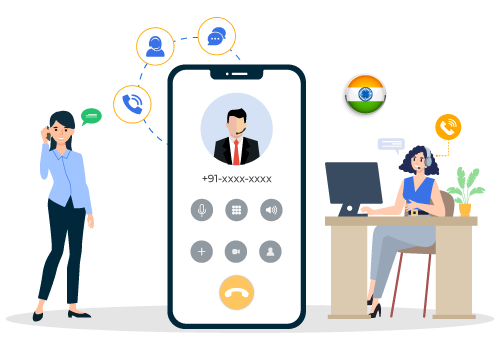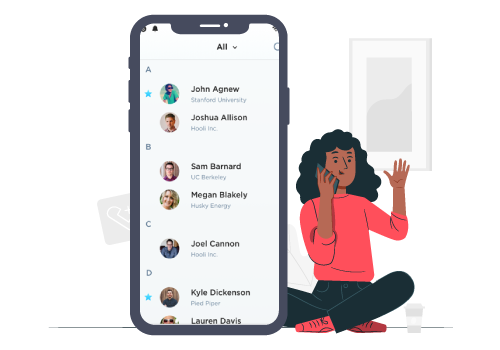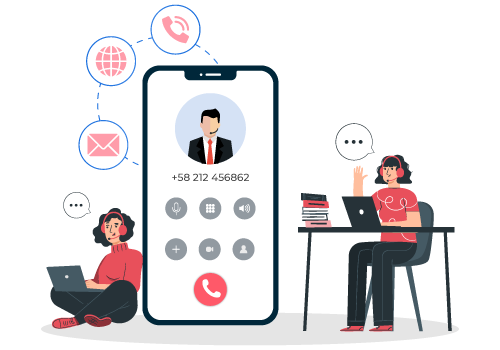Get A Virtual Phone Number
A virtual phone number from CallHippo connects your business to customers anywhere without physical phone lines. Get a virtual number in minutes to establish a local presence, support remote teams, and streamline customer communication. Buy a virtual business phone number and experience simple, reliable connections.

Historically, businesses were bound to landlines and physical phone numbers tied to specific locations or devices. With a virtual phone number, that restriction no longer applies, opening up vast possibilities for businesses. A virtual phone number for business isn’t location-bound, offering flexibility for remote teams and clients across regions.
Ready to make the switch? Find out how to buy a virtual business phone number that’s customized for your needs.
What Is A Virtual Phone Number?
A virtual phone number is a flexible communication tool for businesses, allowing calls to go through an internet connection rather than traditional landlines. Also called online or digital phone numbers, these numbers aren’t linked to a specific device or location, making them adaptable for modern business needs.
For businesses, a virtual phone number for business offers the freedom to route calls seamlessly to various devices such as a desktop, tablet, or mobile phone without interruption. This is ideal for professionals who may be on the go and need reliable access to calls without sharing a personal number. Additionally, when you buy a virtual number, clients experience a standard call process, unaware of the virtual setup.

How To Get A Virtual Phone Number In Simple Steps?
Here’s how you can get a virtual phone number for your business:
Step 1: Sign up with CallHippo.
Step 2: Choose the country you want. (Example: USA)
Step 3: Select your city. (Example: New York)
Step 4: Pick a local or toll-free number. You can also choose the city phone numbers by name.
Step 5: Configure your settings and add users.
From number buying to inviting your users to making your first call, all it takes to set up your virtual phone system is 3 minutes.
- Buy Numbers
- Add Users
- Start Calling
- Track Calls
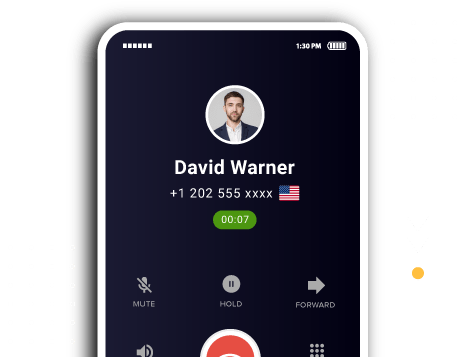
How Do Virtual Phone Numbers Work?
A landline phone number ties you to a physical location, like a desk at your office, limiting mobility. Mobile phone numbers, while more flexible, still rely on a SIM card within one device and are constrained by cell coverage.
CallHippo’s virtual phone numbers, however, break these barriers. Unlike standard phone lines, which use the Public Switched Telephone Network (PSTN), virtual phone numbers use Voice over Internet Protocol (VoIP) technology. You can get a virtual number and take calls on any internet-enabled device whether it’s a smartphone, tablet, or computer no special equipment is needed.
VoIP not only ensures flexibility but also enables a wealth of business-friendly features. With advanced call management features like call forwarding, recording, and analytics, you can buy a virtual phone number for your company. Productivity increases through integration with CRM systems and other business tools, which link all communications to existing workflows.
Essentially, VoIP phone system lets you make and receive calls online. It turns your voice into digital packets, which are then transmitted over the internet and reassembled on the other end all in real-time. The process may be complex, but CallHippo handles these technicalities, so your virtual phone number operates seamlessly.
Benefits Of Getting A Virtual Phone Number With CallHippo
Whether you’re in the office, working remotely, or on the go, CallHippo keeps you connected and accessible with ease. Here are some key advantages of choosing CallHippo for your business.
Using CallHippo’s virtual business phone number removes the need for costly hardware installations. Your existing devices, like phones or computers, can be transformed into a fully functional business phone system, making it a budget-friendly choice.
With CallHippo’s virtual number, establishing a strong local presence in new regions becomes simple. Local virtual numbers improve conversion rates by allowing you to reach out to customers at local call rates, minimizing communication expenses.
CallHippo provides access to virtual phone numbers from various countries, enabling you to communicate with international clients without the hassle of traditional phone services. This global reach helps in establishing a broader business presence.
CallHippo’s virtual numbers integrate seamlessly with IVR, enabling you to share personalized, automated messages. This feature allows callers to reach the right department, reducing wait times and improving overall satisfaction with an efficient experience.
As your business expands, adding new team members to your existing CallHippo system is simple and flexible. With CallHippo, scaling your support or sales team becomes a smooth process, keeping you ready for growth.
With CallHippo, you can access real-time analytics and call-tracking features that allow you to monitor call performance and team productivity. This data-driven approach helps in making informed business decisions and optimizing your communication strategies.
See how your industry peers are succeeding with CallHippo.

The Leading Global Marketplace For Learning And Instruction increased their growth using Callhippo’s business phone solution

Aspire, the Foremost Financial Management Firm, Increased Productivity Leveraging CallHippo’s VoIP Solution.

ActionEdge, a Leading Market Research Service Provider, Achieved Growth Utilizing CallHippo’s Business Phone System

The ease of use and comprehensive features contributed to increase in sales team efficiency.
Integrate with Your Preferred Apps
Integrate all the necessary tools from the CallHippo App Marketplace to further streamline your communication processes.
Modern Virtual Phone Number Features


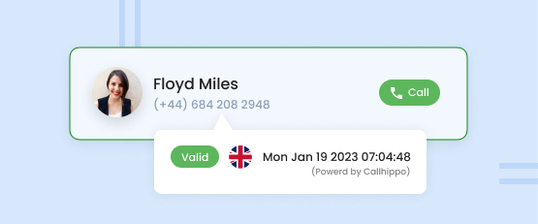


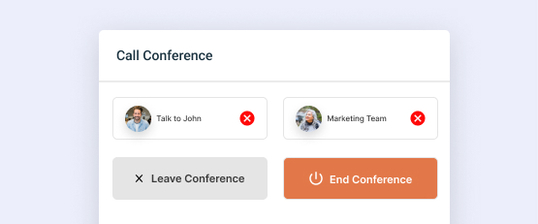

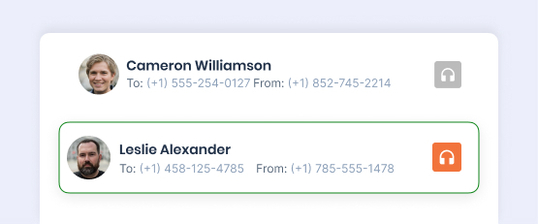
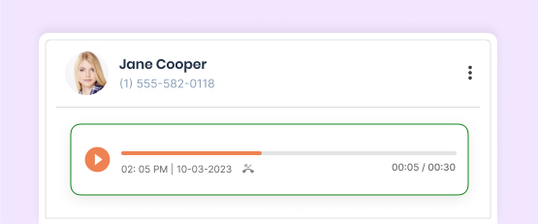
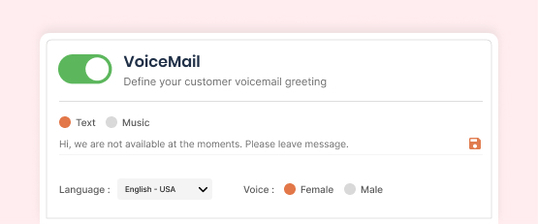
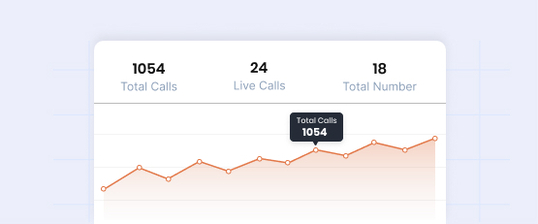
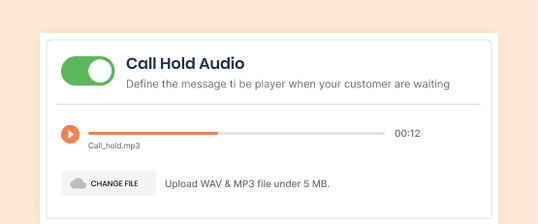
Pricing
- Unlimited Minutes (Includes Both Landline & Mobile Calling)Free minutes are shared by all account users. Calling on special and premium numbers are excluded. For manual calls only.
- 1 Free Phone NumberEach user gets one free phone number. A single number can be assigned to multiple users for making and receiving calls.
- Smart Dashboard
- Paid Call RecordingAdditional charges of $0.005/min are applicable.
- Multiple Integrations
- User Rights
- Chat Support
- Everything in Bronze +
- Unlimited Minutes (Includes Both Landline & Mobile Calling)Free minutes are shared by all account users. Calling on special and premium numbers are excluded. For manual calls only.
- Live Call
- Role-based Access Control
- Free Call Recordings
- Pause-Resume Recording
- After Call Work
- Call Dispositions
- Everything in Silver +
- Unlimited Minutes (Includes Both Landline & Mobile Calling)Free minutes are shared by all account users. Calling on special and premium numbers are excluded. For manual calls only.
- Auto Dialer (Power, Parallel & Speed to Dial)Telephony extra.
- Unlimited QA Users
- Voice Broadcasting
- AI Reports / AnalyticsSmart reports that summarize user & call activity.
- Single Sign On (SSO)Securely log into multiple apps with one set of credentials.
- AI Smart DID Routing
- Hide Number From Agent
- Free Omnichannel Inbox
- Call & SMS Automation
- AI Chat Agents
- AI Workflows
- CSAT Score
- Free Flow Builder
Talk To Us
- Includes all features from past plans
- Minimum 20 Users
- Unlimited calling to 48 countries
- Customized Add-ons for other countries & SMS
- Power Dialer, Parallel Included
- Speech Analytics Or CallHippo AI included
- Priority Support1-hour response time guarantees, designated support team oversight, tailored proactive monitoring and 24/7 support.
- Custom ReportsCustomised reports for tracking teams KPI's.
- Custom OnboardingPersonalised guidance for feature activation and better usage of core CallHippo features.
- Custom data storage and API usage.
- Developer SupportNeed Developer access for support required in software integration.
- Dedicated Account Manager
- Dedicated Compliance SupportTailored assistance from our Legal and Compliance teams to meet specific cybersecurity and documentation needs.
- Unlimited Minutes (Includes Both Landline & Mobile Calling)Free minutes are shared by all account users. Calling on special and premium numbers are excluded.
- 100 SMS (Text Messages)Standard A2P charges apply.
- 1 Free Phone NumberToll-free number not included.
- Basic Report Analytics
- Everything in Starter +
- Unlimited Minutes (Includes Both Landline & Mobile Calling)Free minutes are shared by all account users. Calling on special and premium numbers are excluded.
- 500 SMS (Text Messages)Standard A2P charges apply.
- Call Recordings
- AI Reports / AnalyticsSmart reports that summarize user & call activity.
- Everything in Professional +
- Unlimited Minutes (Includes Both Landline & Mobile Calling)Free minutes are shared by all account users. Calling on special and premium numbers are excluded.
- 1000 SMS (Text Messages)Standard A2P charges apply.
- Dedicated Account Manager
- Custom Integrations
- Single Sign On (SSO)Securely log into multiple apps with one set of credentials.
Talk To Us
- Includes all features from past plans
- Minimum 20 Users
- Unlimited calling to 48 countries
- Customized Add-ons for other countries & SMS
- Power Dialer, Parallel Included
- Speech Analytics Or CallHippo AI included
- Priority Support1-hour response time guarantees, designated support team oversight, tailored proactive monitoring and 24/7 support.
- Custom ReportsCustomised reports for tracking teams KPI's.
- Custom OnboardingPersonalised guidance for feature activation and better usage of core CallHippo features.
- Custom data storage and API usage.
- Developer SupportNeed Developer access for support required in software integration.
- Dedicated Account Manager
- Dedicated Compliance SupportTailored assistance from our Legal and Compliance teams to meet specific cybersecurity and documentation needs.
-
Yes, virtual phone numbers are safe. They safeguard your privacy by using encryption and secure connections, guaranteeing the confidentiality of your calls and texts.
-
Yes, you can use a virtual phone number across different devices. It provides flexibility and simplicity by allowing basic communication on PCs, tablets, and smartphones.
-
Yes, you can have toll-free virtual phone numbers. These numbers increase accessibility and client satisfaction by enabling callers to reach your company without being charged.
-
VoIP numbers and virtual numbers differ in function. VoIP numbers are voice-over internet protocol-based, while virtual numbers refer to any number that isn't tied to a specific phone line.
-
Yes, you can have multiple virtual phone numbers. Many providers allow you to manage several numbers simultaneously, catering to different business needs or personal uses.
-
To get a virtual number in a different country, choose a provider offering international services, select the desired country, and complete the registration process to get your number.
-
When choosing a virtual phone number provider, consider factors like pricing, features, customer support, and coverage. Compare options to find the best fit for your needs.






